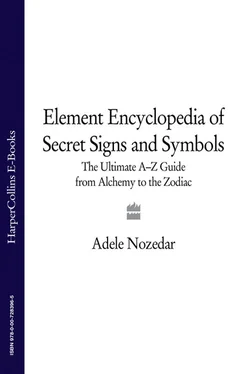Long before the Western discovery of the Americas, the natives of Brazil, Mexico, the West Indies, and South America used the seeds of the chocolatl tree to make a stimulating drink. These bean-like seeds were cacahuatl, or cocoa. Primarily symbolic of love, chocolate is a sensual food with aphrodisiac properties that are due, in part, to association. However, its melting point is the same temperature as blood, a very satisfying sensation.
The botanical name of the plant gives a clue as to its sacred status. Theobroma cacao means “food of the Gods,” from the Greek “Theo,” meaning God and “Broma,” meaning food.
The beans were so highly valued that the Mayans used them as currency. Possibly the world’s first chocoholic, their ruler Montezuma was completely addicted to the beans. He drank them infused in cold water with no seasoning. He served this sacred drink in goblets of beaten gold, and at the coronation of Montezuma II in 1502 a concoction of chocolate and psilocybin mushrooms was served to the guests. This must have been a heady mixture.
Cortés cultivated the plant primarily because of its reputation as an aphrodisiac; this secret was divulged by one of the nineteen young women given to him by Montezuma as a tribute. Perhaps the 2000 chocolatl trees that he consequently planted were testimony to the efficacy of the beans in keeping the ladies satisfied.
By 1550, chocolate factories were operating in Lisbon, Genoa, Marseilles, and other European cities. The recipes became more and more refined. Catherine de Medici slowed down the progress of chocolate for a while because it was so good that she wanted it all to herself. However, although the Church tried to ban many of the foodstuffs that had been discovered in the New World, especially those that were considered as stimulants, their advice was largely ignored and it is possible that this disapproval increased the popularity of this illicit substance. Neither Catherine nor all the forces of the Church could stop the world becoming chocolate coated.
Today, the form of chocolate has changed so much that Montezuma would probably find it unrecognizable, both in taste and form. However, it is still unrivalled as a token and symbol of love.
Legislation decrees that all packaged food carry a “best before” date, but this seems to be particularly unnecessary in the case of honey, since jars of the stuff found in the tombs of Egyptian kings of several thousand years ago has proved to be perfectly edible even now. It could well be because honey is so long lasting, and because it is used as a preservative, that it is a symbol of immortality and is used in funerary rites. The bees that make the honey have their place in the realms of magical creatures accorded with supernatural powers, but more of that in the Fauna section. The Promised Land is said to “flow with milk and honey” as being the very best that the Gods can offer.
The sweetness of honey is believed to confer gifts of learning and poetry. We’ll never know if the story that Pythagoras existed on honey alone is true, but the fact that the rumor exists is in accord with his God-like status. As well as being edible and fermentable, honey has healing and antiseptic qualities, and a dollop of honey smeared onto a wound will soon draw out any impurities and speed the healing process.
Honey is said to be an aphrodisiac and to encourage fertility and virility, wealth and abundance, and is a symbol of the Sun, partly because of the flowers from which it is made but also because of its color.
When the Children of Israel were struggling to survive in the wilderness, manna appeared, miraculously, overnight, and so they could eat. Precisely what manna was—or is—is debatable. Some believe it might be a kind of fungus, others believe that it might be sap or resin exuded from the tamarisk tree. The symbolic meaning of manna is of something provided freely by the Universe or by God and is the ultimate reminder that we have everything we need. Manna is also associated with the Bread of Life or the Eucharist.
Like honey, mead also carries the gift of immortality. The Celts believed it was the favored drink of the Gods in the Otherworld. Mead is a sacred drink in Africa, too, where it is believed that drinking the stuff will make you more knowledgeable. Worth a try! Mead is very simple to make—it’s simply honey mixed with water and allowed to ferment—and this process of fermentation is akin to a magical process in itself, which is akin to transmutation in alchemy.
Given that milk is the first food, it’s not surprising that it is associated with many stories of the Creation, and is a symbol of divinity. Amrita, or soma, the absolute nectar of life for Hindus and the equivalent of ambrosia, was created as a cosmic sea of milk was churned. The curds that were created by this epic stirring formed the Earth, the Universe, and the stars. Along with honey, there is an abundance of milk in the Promised Land, and Indian myths tell of a magical milk tree in Heaven. Because of its color and its association with the feminine, milk is a symbol of the Moon. The main food source for milk for us human beings (once we’re weaned) is the cow. The cow is sacred in India because during times of famine it made far more sense to keep the animal alive for its milk rather than slaughter and eat it purely for its meat, so all parts of the cow are accorded sacred status and are ruled over by one or other of the Gods or Goddesses.
In the hidden symbolic language of alchemy, the Philosopher’s Stone is sometimes called the Virgin’s Milk.
Nectar is often referred to as ambrosia, but has secrets of its own to tell. Flowers create it, and its scent attracts the bees, which then transform the nectar into honey. Seemingly insignificant, nectar is nevertheless a very magical ingredient, created from flowers, sunshine, and bees working together in a collective consciousness known as the “hive mind” in an environment which itself is constructed from one of the key shapes in sacred geometry, the hexagon.
Like the Greek Olympians, the Indian deities had a type of food, like ambrosia, that ensured their immortality. This was soma, or amrita. Whereas dire consequences befell any mortal that dared to partake of ambrosia, the Indian Gods were more generous with their soma, and any mortal that ate it was immediately given immortality and access to Heaven. The ancient Indian Vedic scriptures, the Ramayana, tell the story of Rama, an epic hero, the perfect man. Rama was born after his father was visited by an angel. This angel brought with him some magical food. Eating this soma meant that Rama’s father was able to sire offspring that were the human incarnations of the God, Vishnu.
The symbolic meanings of wine are generally attached to the red variety; it seems that a nice dry white or a sweet rosé carries no hidden mystery. Here are some things to think about next time you open a nice bottle of claret.
The red color means that wine is often linked to blood, particularly since the wine is the “blood” of the grape. Because it looks like blood, wine is often used in rituals where blood would otherwise be called for, and because ceremonial wine is often drunk from a shared chalice, it is seen, like bread, as a unifying principle. Wine is male, and bread is female. As a partner to bread in the ritual of the Eucharist, the consecrated wine is transformed into the blood of the Christ, a reminder of both sacrifice and immortal life, and it’s this transformative power that accords wine with much of its mystique. When the water is turned into wine in the story of the Marriage at Cana, what is really being shown here is the transformation of the mundane into the magical, the Earthly into the Heavenly. It is this magical process of fermentation at work that explains why wine is associated with Bacchus/Dionysus, and the intoxicating power of wine is symbolic of divine possession.
Читать дальше












